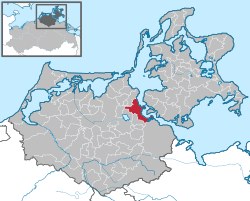Stralsund
Stralsund | |
|---|---|
|
Clockwise from top: view over the city withSt Nicholas Church;skyline of the city seen fromAltefährat night; city hall; view over the city and its three city ponds;Ozeaneum,St Mary's Churchand St James' Church; St James' Church | |
| Coordinates:54°18′33″N13°04′55″E/ 54.30917°N 13.08194°E | |
| Country | Germany |
| State | Mecklenburg-Vorpommern |
| District | Vorpommern-Rügen |
| Founded | 1168 |
| Government | |
| •Lord mayor(2022–29) | Alexander Badrow[1](CDU) |
| Area | |
| • Total | 54.07 km2(20.88 sq mi) |
| Elevation | 13 m (43 ft) |
| Population (2022-12-31)[2] | |
| • Total | 59,363 |
| • Density | 1,100/km2(2,800/sq mi) |
| Time zone | UTC+01:00(CET) |
| • Summer (DST) | UTC+02:00(CEST) |
| Postal codes | 18435, 18437, 18439 |
| Dialling codes | 03831 |
| Vehicle registration | HST |
| Website | www.stralsund.de |
Stralsund(German pronunciation:[ˈʃtʁaːlzʊnt];Swedish:Strålsund),[3]officially theHanseaticCity of Stralsund(German:Hansestadt Stralsund), is the fifth-largest city in the northeastern German federal state ofMecklenburg-Western PomeraniaafterRostock,Schwerin,NeubrandenburgandGreifswald,and the second-largest city in thePomeranianpart of the state. It is located on the southerncoastof theStrelasund,asoundof theBaltic Seaseparating the island ofRügenfrom the Pomeranianmainland.[4]
TheStrelasund Crossingwith its two bridges and several ferry services connects Stralsund with Rügen, the largest island of Germany and Pomerania.[4]TheWestern Pomeraniancity is the seat of theVorpommern-Rügendistrict and, together withGreifswald,Stralsund forms one of four high-levelurban centres of the region.
The city's name as well as that of theStrelasundare compounds of theSlavic(Polabian)stralandstrela(arrow;Polish: strzała, Czech: střela) and theGermanicsund,astraitorsound.Thecanting armsof the city make reference to that etymology as well as to Stralsund'sHanseaticpast in featuring a silvercross pattée(a Hanseatic Cross) above a silver arrow.
Stralsund was granted city rights in 1234 and is thus the oldest city in Pomerania. It was one of the most prosperous members of the medievalHanseatic League.In 1628, during theThirty Years' War,the city came underSwedishrule and remained so until the upheavals of theNapoleonic Wars.It was the capital ofSwedish Pomerania(New Western Pomerania) from 1720 to 1815. From 1815 to 1945, Stralsund was part ofPrussia.
Stralsund's old town was inscribed as aUNESCO World Heritage Sitein 2002 alongsideWismarinMecklenburgbecause of its outstandingBrick Gothicbuildings and importance during the Hanseatic League and Swedish rule.[5]St Mary's Churchhas been the tallest church in the world from 1549 to 1569 and from 1573 to 1647. The city's other two large churches areSt Nicholas'and St James'. Stralsund is the seat of theGerman Oceanographic Museum(Deutsches Meeresmuseum) with its satellitesOzeaneum(in Stralsund), Nautineum (onDänholm Island), andNatureum(on theFischland-Darß-Zingst Peninsula).
The main industries of Stralsund areshipbuilding,fishing,mechanical engineering,and, to an increasing degree,tourism,life sciences,services andhigh techindustries, especiallyinformation technologyandbiotechnology.
Geography[edit]

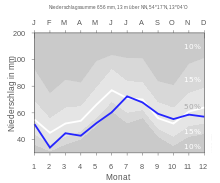
Location[edit]
The city of Stralsund is located in northeasternGermanyin the region ofWestern Pomeraniain the state ofMecklenburg-Vorpommern.Stralsund is located south west ofRügen.It is separated by a small body of water named the Strelasund, which stretches out to the Baltic Sea.
Climate[edit]
Itsannual precipitationis 656 mm (25.8 inches) and comparatively low, falling within the lowest third of all precipitation values inGermany.The driest month is February; the most precipitation falls in July. The precipitation varies relatively moderately throughout the year. Only 40% of weather stations in Germany exhibit lower seasonal variation.
| Climate data for Stralsund, elevation: 13 m, 1991–2021 normals | |||||||||||||
|---|---|---|---|---|---|---|---|---|---|---|---|---|---|
| Month | Jan | Feb | Mar | Apr | May | Jun | Jul | Aug | Sep | Oct | Nov | Dec | Year |
| Mean daily maximum °C (°F) | 2.9 (37.2) |
3.7 (38.7) |
6.9 (44.4) |
12.0 (53.6) |
16.6 (61.9) |
19.8 (67.6) |
22.2 (72.0) |
21.8 (71.2) |
18.1 (64.6) |
12.9 (55.2) |
7.8 (46.0) |
4.4 (39.9) |
12.4 (54.4) |
| Daily mean °C (°F) | 1.1 (34.0) |
1.4 (34.5) |
3.8 (38.8) |
8.1 (46.6) |
12.8 (55.0) |
16.2 (61.2) |
18.7 (65.7) |
18.3 (64.9) |
14.9 (58.8) |
10.3 (50.5) |
5.9 (42.6) |
2.7 (36.9) |
9.5 (49.1) |
| Mean daily minimum °C (°F) | −0.9 (30.4) |
−0.8 (30.6) |
0.7 (33.3) |
4.2 (39.6) |
8.6 (47.5) |
12.2 (54.0) |
14.9 (58.8) |
14.7 (58.5) |
11.8 (53.2) |
7.8 (46.0) |
3.9 (39.0) |
0.9 (33.6) |
6.5 (43.7) |
| Averageprecipitationmm (inches) | 54.0 (2.13) |
45.0 (1.77) |
50.0 (1.97) |
48.0 (1.89) |
62.0 (2.44) |
77.0 (3.03) |
84.0 (3.31) |
82.0 (3.23) |
61.0 (2.40) |
56.0 (2.20) |
52.0 (2.05) |
55.0 (2.17) |
726 (28.59) |
| Average precipitation days | 9 | 8 | 8 | 8 | 9 | 9 | 10 | 10 | 8 | 8 | 9 | 9 | 105 |
| Mean monthlysunshine hours | 83.7 | 103.6 | 164.3 | 261.0 | 313.3 | 318.0 | 331.7 | 303.8 | 219.0 | 155.0 | 90.0 | 71.3 | 2,414.7 |
| Source: Climate-Data.org[6] | |||||||||||||
Landscape[edit]
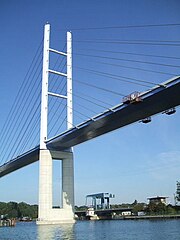
The city lies on the sound ofStrelasund,astraitof theBaltic Sea.Its geographic proximity to the island ofRügen,whose only fixed link to the mainland, theStrelasund Crossing,runs between Stralsund and the village ofAltefähr,has given Stralsund the sobriquet "Gateway to the Island of Rügen" (Tor zur Insel Rügen). Stralsund is located close to theWestern Pomerania Lagoon Area National Park.
Stralsund's city borough includes municipal forest and three municipal ponds (theKnieperteich, FrankenteichandMoorteich.The three ponds and the Strelasund lend the Old Town, the original settlement site and historic centre of the city, a protected island ambience. The highest point of the city is theGalgenberg( "Gallows Hill" ) on its western approaches.
Subdivisions[edit]
The city's territory covers an area of 54.07 km2,which makes Stralsund, with its nearly 58,000 inhabitants one of the most densely populated cities inMecklenburg-Western Pomerania(1,480 inhabitants per km2).
The borough of the Hanseatic city of Stralsund is divided into as follows:
| No. | Area | Quarter | Population (as of Dec. 2015[7]) |
|---|---|---|---|
| 01 | Altstadt (Old Town) | 5,942 | |
| 011 | Altstadt | Altstadt | 5,630 |
| 012 | Altstadt | Hafeninsel (Harbour Island) | 24 |
| 013 | Altstadt | Bastionengürtel | 288 |
| 02 | Knieper | 24,966 | |
| 021 | Knieper | Kniepervorstadt | 6,059 |
| 022 | Knieper | Knieper Nord | 6,597 |
| 023 | Knieper | Knieper West | 12,310 |
| 03 | Tribseer | 9,876 | |
| 031 | Tribseer | Tribseer Vorstadt | 5,204 |
| 032 | Tribseer | Tribseer Siedlung | 3,431 |
| 033 | Tribseer | Tribseer Wiesen | 1,129 |
| 034 | Tribseer | Schrammsche Mühle | 112 |
| 04 | Franken | 6,660 | |
| 041 | Franken | Frankenvorstadt | 5,209 |
| 042 | Franken | Dänholm | 316 |
| 043 | Franken | Franken Mitte | 365 |
| 044 | Franken | Frankensiedlung | 770 |
| 05 | Süd | 3,947 | |
| 051 | Süd | Andershof | 3,297 |
| 052 | Süd | Devin | 576 |
| 053 | Süd | Voigdehagen | 74 |
| 06 | Lüssower Berg | 225 | |
| 07 | Langendorfer Berg | 318 | |
| 08 | Grünhufe | 6,307 | |
| 081 | Grünhufe | Stadtkoppel | 320 |
| 082 | Grünhufe | Vogelsang | 2,240 |
| 083 | Grünhufe | Grünthal-Viermorgen | 3,687 |
| 084 | Grünhufe | Freienlande | 60 |
The city also possesses estates in the local area as well as on the islands ofRügen,HiddenseeandUmmanz.
Neighbouring municipalities[edit]
Larger cities in the nearby area areGreifswaldandRostock.In the local area around Stralsund there are also the towns ofBarthandRibnitz-Damgarten.
Many of the smaller villages in the vicinity, likeProhnorNegast,have grown sharply after 1990 as a result of the influx of those living or working in Stralsund.
History[edit]
Historical affiliations
Principality of Rügen1168–1325
Duchy of Pomerania1325–1648
Sweden1648–1807
French Empire1807–1809
Prussian rebels1809
French Empire1809–1810
Sweden1810–1812
French Empire1812–1813
Sweden1813–1814
Denmark,1814-1815
Kingdom of Prussia,1815-1918
German Reich,1918–1945
Soviet occupation zone1945–1949
German Democratic Republic1949–1990
Federal Republic of Germany1990–present

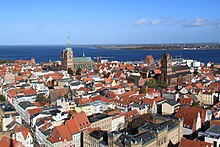

In theMiddle Agesthe Stralsund area formed part of theWest SlavicPrincipality of Rügen.At that time theDänholmisle and fishing village, both at the site of the latter city, were calledStraleorStralow,Polabianfor "arrow" (this meaning underlies the city's coat of arms, which shows an arrow). The full Polabian name can be rendered inPolishasStrzałów.[8]
The village also had a ferry to the island of Rügen.[9]In 1168, following thesiege of Arkona,the Principality of Rügen became part ofKingdom of Denmark.
In the course ofGermanOstsiedlung,many German settlers, gentry and merchants were invited to settle in the principality, and they eventually populated theStralesettlement. Merchants from other countries as well as locals were attracted to the area and made up one third of the settlement's population. The Danish navy used the isle as well. When the settlement had grown to town size, princeWizlaw Iof Rügen grantedLübeck lawto "our town Stralow" in 1234, although a significant settlement had existed long before the formal founding.[9]In 1240, when the prince gave additional land to the town, he called itStralesund.
The success of the settlement challenged the powerfulFree City of Lübeck,which burnt Stralsund down in 1249. Afterwards the town was rebuilt with a massivetown wallhaving 11town gatesand 30 watchtowers. TheNeustadt,a town-like suburb, had merged with Stralsund by 1361.Schadegard,a nearby twin city to Stralsund also founded by Wizlaw I, though not granted German law, served as the principal stronghold and enclosed a fort. It was given up and torn down by 1269 under pressure from the StralsundBürger.
In 1293 Stralsund became a member of theHanseatic League.[4]A total of 300shipsflying the flag of Stralsund cruised theBaltic Seain the 14th century. In 1325 thePrincipality of Rügenbecame part of theDuchy of Pomerania,Stralsund however maintained a considerable independence.
In the 17th century opposing forces in theThirty Years' Warfought over Stralsund. In theBattle of Stralsund (1628),the Imperial (Catholic) forces commanded byAlbrecht von Wallensteinbesieged the city after the council refused to accept theCapitulation of Franzburg[10]of November 1627. Stralsund resisted withDanishandSwedishsupport.[10]The Swedish garrison in Stralsund was the first on German soil in history.[10]With theTreaty of Stettin (1630),the city became one of two major Swedish forts in theDuchy of Pomerania,alongsideStettin(nowSzczecin,Poland).[11]
After the war, thePeace of Westphalia(1648) and theTreaty of Stettin (1653)made Stralsund part ofSwedish Pomerania.Lost toBrandenburgin theBattle of Stralsund (1678),it reverted to Sweden in theTreaty of Saint-Germain-en-Laye (1679).In theGreat Northern Warin 1715Charles XIIled thedefence of Stralsundfor a year against the united European armies. Stralsund remained under Swedish control until theBattle of Stralsund (1807),whenNapoleon Bonaparte's army occupied it. Seized byFerdinand von Schill'sfreikorpsin 1809, itsubsequently reverted to French control,with Schill killed in action. With theCongress of Vienna(1815), Stralsund became a part of thePrussianProvince of Pomeraniaand the seat of agovernment regionresembling the formerSwedish Pomerania.
Following theFirst World WarStralsund suffered the same sort of political unrest and unemployment that afflicted much of Germany. In May 1919 Stralsund workers clashed with police, and martial law was declared. In the early 1920s theIndependent Social Democratic Party(USPD) became the strongest party in Stralsund, but its political fortunes waned rapidly, and in September 1922 it reunited with theSocial Democratic Party(SPD). TheStralsunder Zeitungwas published as a local newspaper in Stralsund.
In the national parliamentary election of May 1924, the conservativeGerman National People's Party(DNVP) polled 8,547 votes in Stralsund, the SPD 3,534, the Communists 1,825 and theGerman People's Party(DVP) of Foreign MinisterGustav Stresemann1,417. However, in keeping with national trends,Hitler'sNational Socialistsmade rapid gains in the late 1920s, and by the time of the last free national election in July 1932 the Nazis polled twice as many votes in Stralsund as the SPD.
During the Nazi period (1933–1945), Stralsund's military installations expanded, and a naval training base opened on the nearby island ofDänholm.InWorld War IIthe city was subjected torepeated Allied bombing.Attacks by the U.S. Army Air Forces in 1944 killed some 800 Stralsunders and destroyed an estimated 8,000 dwellings. The354th Rifle Divisionof theRed Armyoccupied Stralsund on April 28, 1945 – 10 days before the end of the war in Europe. Approximately half its population had fled.
During the period of theGerman Democratic Republic(GDR), Stralsund saw the construction of numerousPlattenbauprefabricated apartment blocks. Its economic life centered on the now state-owned shipyard, which largely focussed on building ships for theSoviet Union.
AfterGerman reunificationin 1990, the city's historic old town was thoroughly restored, and Communist-era apartment blocks were renovated and upgraded. In 2002 the old towns of Stralsund andWismar,some 120 km to the west, were listed asUNESCO World Heritage Sites.Stralsund's shipyard was privatized, and thereafter specialized in constructing container ships.
Culture and sights[edit]
| UNESCO World Heritage Site | |
|---|---|
 Stralsund: Alter Markt Square with the city hall and the St. Nicholas Church | |
| Part of | Historic Centres of Stralsund andWismar |
| Criteria | Cultural: ii, iv |
| Reference | 1067 |
| Inscription | 2002 (26thSession) |
| Area | 80 ha |
| Buffer zone | 340 ha |
Main sights[edit]
- The historic Stralsund old town island is aUNESCOWorld Heritage Site.It features many valuable remnants of the Hanseatic time,Brick Gothic,renaissance,baroque,historicistandJugendstilbuildings.[5]
- The heart of the old town is the Alter Markt Square ( "Old Market" ), with the Gothic city hall (13th century). Behind the city hall soars the imposingSt. Nicholas' Church,built in 1270–1360. The square is surrounded by houses from different periods, including the GothicWulflamhaus(a 14th-century patrician house, today a restaurant), and the BaroqueCommandantenhusof 1751, the old headquarters of the Swedish military commander.
- Saint James' Church, built in mid-14th century. It was destroyed several times, e.g. byWallensteinand inWorld War II.
- Saint Mary's Church,built in 1383–1473 inGothic style,is the largest church in Stralsund, and from 1625 to 1647 it was theworld's tallest structure.Its octagonal tower (104 meters high) offers a panorama view of Stralsund and the neighboring islands ofRügenandHiddensee.

- St. John's Abbey (Franciscan monastery built in 1254) is one of the oldest buildings in the city.
- Stralsund is the port of registry for the former GermanReichsmarineNavy Sail Training ship"Gorch Fock" 1.It is now a floating museum.
- The Monastery of Saint Catherine, mainly built in the 15th century, houses two museums today: Stralsund'sMuseum of Cultural History(known for e.g. theGold Jewellery of Hiddensee),[12]and theGerman Oceanographic Museum,Germany's largest aquarium and oceanographic collection. The ancientrefectoryof the monastery is one of the most spectacular Gothic interiors in Germany.
- Besides the mentionedGerman Oceanographic Museumat the Katharinenkloster, Stralsund has other museums dedicated to marine life, including the popularOzeaneumthat was votedEuropean Museum of the Yearin 2010. There is also a nautical centre, the Nautineum, onDänholmisland and theMarinemuseum Dänholm,showcasing the military history of the German Navy, especially the interwarReichsmarine.It also hosts one of the last remaining GDRVolksmarine(People's Navy) torpedo boats.
Buildings and monuments[edit]
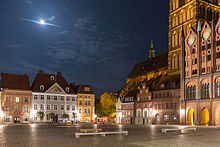
- Old Town (Altstadt)
The centre of Stralsund has a wealth of historic buildings. Since 1990, large parts of the historic old town have been renovated with private and public capital, and with the support of foundations. As a result of the contempt for historic buildings inEast Germanymany houses were threatened by ruin. The Old Town in particular offers a rich variety of historic buildings, with many former merchants' houses, churches, streets and squares.
Of more than 800 listed buildings in Stralsund, more than 500 are designated as individual monuments in the Old Town. In twenty years, from theWende(turning point) in 1990 to November 2010, 588 of the more than 1,000 old buildings were completely refurbished, including 363 individual monuments.[13]Because of its historical and architectural significance, in 2002 Stralsund's old town together with the old town ofWismarwere added to entitled theUNESCO World Cultural Heritage listas the "Historic Centres of Stralsund and Wismar".[5]

- Alter Markt Square
On the Alter Markt Square there is the main landmark of Stralsund: theBrick Gothiccity hall fromHanseatictimes. This building from 1278 features a remarkable "show façade" that serves the sole purpose of displaying wealth of the city. Citizens can walk through the city hall and itsgallery.It also features one of Europe's largest Gothiccellar vaults.The ensemble of buildings on the Alter Markt Square includes the St. Nicholas Church, the Artushof, the Wulflamhaus, the Commandantenhus, the Gewerkschaftshaus and a new apartment complex.
- Old Town houses
The historic houses with their distinctive gables, often renovated at a high financial cost, dominate the scene in the streets of the Old Town. The former Swedish Government Palace is now home to the city construction department. The Museum of Cultural History Museum inMönchstrasse,in one of the most important surviving original houses of theHanseaticera, was refurbished with funds from theGerman Foundation for Monument ConservationIt offers a guide to understanding the city's history over seven centuries.
- Churches
Three largemedievalBrick Gothicbuildings –St. Mary's Church,St. Nicholas Churchand St. James Church, point to the medieval significance of Stralsund. Today St. James' is used purely as a cultural venue, its parish being served now by the Church of the Holy Spirit, which also dates from the 14th century. Two other churches on the Alter Markt Square and the Neuer Markt are still used for church services. The tower of St. Mary's on the Neuer Markt offers a panoramic view over Stralsund and the island of Rügen.
- Monasteries
St. John's Abbey, aFranciscanmonastery from 1254, now houses the Stralsund City Archives. Regular cultural events also take place here, such as open-air theatre productions.
The Gothic abbey of St. Anne and St. Bridget inSchillstrassewas established around 1560 from the merger of the abbey ofSt. Anne(1480) and the double abbey ofMariakron(1421).
The Abbey of St. Jürgen onMönchstrassewas mentioned in 1278 for the first time. It served in the 14th century as an old people's home. In 1743 a new building, theKleines St. Jürgen Kloster,was built atKniepertorand the site was extended in 1754 to create old people's flats and in 1841 for widow's apartments.
First mentioned in 1256, theHeilgeistklosteris now the Hospital of the Holy Spirit.

- Port
Ferries toHiddenseeandAltefähr,as well as harbor tour boats, dock at the port. In the summer months the port is a berthing places for river cruisers. There are several yacht harbors and marinas near the Old Town. Hundreds of yachts and boats tie up along the north mole in summer. Architecturally the pilot station and the harbor warehouse (Hafenspeicher), as well as the silhouette of the Old Town, form a unique tableau of different historical eras. The barque and former sailor's training ship,Gorch Fockis another tourist attraction at the harbor.
Education[edit]

The Fachhochschule Stralsund is aUniversity of Applied Sciences[14]with a modern campus, north of the old town at theStrelasund.It has around 2,500 students and is among thebest rankedpublic universities in Germany in various fields, especially in economics.[15]Other university departments are Mechanical Engineering, Electrical Engineering and Information Technology. The FH Stralsund also offers international study programs, such asLeisure and Tourism Management[16]andBaltic Management Studies(international business management).[17]
Transport[edit]
Stralsund is linked to theA20 motorway(towardsBerlinandHamburg), via theB96ndual-carriageway. Other major roads include the B105 (beginning in the city centre and continuing toRostock) and theB96(major road toRügen) and the B194 to the town ofGrimmen.
Stralsund Hauptbahnhofis on theline to Berlin,Rostock,PasewalkandBergen.
When travelling by air, passengers usually do so viaRostock-Laage Airportwith connecting flights fromMunich.A small airport,Stralsund Barth Airport,also serves the city locally.
City buses are run by SWS (Stadtwerke Stralsund).
Twin towns – sister cities[edit]
Sport[edit]
Association football[edit]
FC Pommern Stralsundwere a football team that existed from 1994 to 2018. They were the successor to ASG Vorwärts Stralsund.
Motorcycle speedway[edit]
ThePaul Greifzu Stadiumbuilt in 1957, off the Barther Straße,[19]hosts the speedway team MC Nordstern Stralsund e.V.[20]The team based at the stadium won theGerman Team Speedway Championshipin 2015 and 2022.[21]
Notable people[edit]

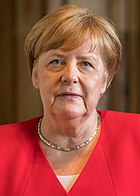
Public service and commerce[edit]
- Thomas Kantzow(c.1505–1542), chronicler of theDuchy of Pomerania
- Bartholomäus Sastrow(1520–1603), official, notary and mayor of Stralsund
- Nicodemus Tessin the Elder(1615–1681), Swedish architect
- Carl Gustav Rehnskiöld(1651–1722), SwedishField marshal
- Philip Johan von Strahlenberg(1676–1747), Swedish officer and geographer
- CountJohan August Meijerfeldt the Younger(1725–1800), a Swedishfield marshal.
- Ernst Moritz Arndt(1769–1860), nationalist author, poet, fighter against serfdom.[22]
- Ferdinand von Schill(1776–1809), leader of a revolt against French domination.[23]
- Carl Georg Schwing(1778–1858), jurist and mayor of Stralsund
- Georg Friedrich Schömann(1793–1879), classical scholar.[24]
- Arnold Ruge(1802–1880), philosopher and political writer.[25]
- Adolf Heinrich von Arnim-Boitzenburg(1803–1868), Prime minister of Prussia
- Hermann von Mallinckrodt(1821–1874), parliamentarian from the Province of Westphalia
- Eduard von Jachmann(1822–1887),vice admiralof thePrussian Navy
- Erich Haupt(1841–1910), Lutheran theologian.[26]
- Leonhard Tietz(1849–1914), merchant, opened his first department store in Stralsund in 1879
- Georg Wertheim(1857–1939), merchant, founded theWertheimchain of department stores
- Johannes Kromayer(1859–1934), classical historian
- Wolfram Setz(1941–2023), historian, editor and translator
- Angela Merkel(born 1954), politician; her office is still located on the main shopping street
- Dietmar Bartsch(born 1958), politician, member of the Bundestag
Science[edit]

- Carl Wilhelm Scheele(1742–1786), Swedish Pomeranian / German pharmaceutical chemist.[27]
- Christian Ehrenfried Weigel(1748–1831), scientist
- Hermann Burmeister(1807–1892), German-Argentine zoologist, entomologist and botanist[28]
- William Lindley(1808–1900), engineer, designed water and sewerage systems
- Wilhelm Ferdinand Erichson(1809–1848), medical doctor and entomologist
- Otto Gottlieb Mohnike(1814–1887), physician and naturalist
- Gustav Karl Wilhelm Hermann Karsten(1817–1908), botanist and geologist
- Ernst Kromayer(1862–1933), dermatologist and inventor
- Karl Grunberg(1875–1932),otologist
The Arts[edit]

- Hermann Raupach(1728–1778), composer
- Paul Struck(1776–1820), composer
- Joachim Nicolas Eggert(1779–1813), Swedish composer andmusical director
- Joachim Daniel Andreas Müller(1812–1857), Swedish gardener and writer
- Heinrich Kruse(1815–1902), dramatist, publicist and playwright[29]
- Friedrich Spielhagen(1829–1911), novelist, literary theorist and translator.[30]
- Hermann Carl Hempel(1848–1921), landscape painter
- Hans-Heinz Dräger(1909–1963), German-American musicologist
- Harry Kupfer(1935–2019), opera director, worked at theStralsund Theatre1958–1962
- Nadja Uhl(born 1972), actress
Sport[edit]
- Olaf von Schilling(born 1943), swimmer
- Helmut Losch(1947–2005), weightlifter, bronze medallist at the1976 Summer Olympics
- Jürgen Heuser(born 1953), weightlifter, silver medallist at the1980 Summer Olympics
- Monika Kallies(born 1956), rower, gold medallist at the1976 Summer Olympics
- Silke Möller(born 1964), athlete, team bronze medallist at the1988 Summer Olympics
- Carsten Embach(born 1968), bobsledder, team gold medallist at the2002 Winter Olympics
- Ulrike Maisch(born 1977), long-distance runner
- Eric Koreng(born 1981), beach volleyball player
Gallery[edit]
-
St. Mary's Church
-
Stralsund
-
St. Nicolas Church
-
Founding document from 1234
See also[edit]
References[edit]
- ^Kommunalwahlen in Mecklenburg-Vorpommern, Ergebnisse der Bürgermeisterwahlen,Mecklenburg-Vorpommern, Landesamt für innere Verwaltung, accessed 13 November 2022.
- ^"Bevölkerungsstand der Kreise, Ämter und Gemeinden 2022"(XLS)(in German).Statistisches Amt Mecklenburg-Vorpommern.2023.
- ^"Stralsunds, Britannica".Britannica.Retrieved2018-04-24.
- ^abcBritannicaOnline Encyclopedia,"Stralsund" (city), 2007, webpage:EB-Stralsund.
- ^abc<"Historic Centres of Stralsund and Wismar".UNESCO World Heritage Centre.United Nations Educational, Scientific, and Cultural Organization.Retrieved27 August2022.
- ^"Climate normals for Germany 1991-2021"(in German). climate-data.org.Retrieved25 October2022.
- ^www.stralsund.deArchived2016-05-20 at theWayback Machine,accessed on 24 July 2016 (pdf)
- ^S. Kozierowski, 1934. Atlas nazw geograficznych Słowiańszczyzny Zachodniej. Poznań: Nauka i Praca.
- ^ab"Two Cities – One Heritage".History.Historic Centres of Stralsund and Wismar. Archived fromthe originalon 2013-05-15.Retrieved2013-04-07.
- ^abcLanger, Herbert (2003)."Die Anfänge des Garnisionswesens in Pommern".In Asmus, Ivo; Droste, Heiko; Olesen, Jens E. (eds.).Gemeinsame Bekannte: Schweden und Deutschland in der Frühen Neuzeit(in German). Berlin-Hamburg-Münster: LIT Verlag. pp. 402–403.ISBN3-8258-7150-9.
- ^ Langer, Herbert (2003)."Die Anfänge des Garnisionswesens in Pommern".In Asmus, Ivo; Droste, Heiko; Olesen, Jens E. (eds.).Gemeinsame Bekannte: Schweden und Deutschland in der Frühen Neuzeit(in German). Berlin-Hamburg-Münster: LIT Verlag. p. 39.ISBN3-8258-7150-9.
- ^Museum of Cultural History Stralsund
- ^64 Häuser in der Altstadt auf der Missstands-Liste,in:Ostsee-ZeitungStralsund dated 4 November 2010
- ^"University of Applied Sciences Stralsund".Archived fromthe originalon 2014-01-17.Retrieved2012-10-11.
- ^CHE University Ranking Germany(CHE Hochschulranking 2012/13),Die Zeit
- ^Leisure and Tourism Management at FH Stralsund
- ^Baltic Management Studies at FH Stralsund,international study program
- ^"Städtepartnerschaften und internationale Beziehungen".stralsund.de(in German). Stralsund.Retrieved2021-04-04.
- ^"Paul-Greifzu-Stadion".Hallenbelegung.Retrieved28 January2024.
- ^"Home Page".MC Nordstern Stralsund e.V.Retrieved28 January2024.
- ^"Bundesliga".Speedway Fansite.Retrieved6 May2024.
- ^.Encyclopædia Britannica.Vol. 2 (11th ed.). 1911. pp. 627–628.
- ^.Encyclopædia Britannica.Vol. 24 (11th ed.). 1911. pp. 323–324.
- ^.Encyclopædia Britannica.Vol. 24 (11th ed.). 1911. p. 357.
- ^.Encyclopædia Britannica.Vol. 23 (11th ed.). 1911. p. 821.
- ^.New International Encyclopedia.Vol. IX. 1905.
- ^.Encyclopædia Britannica.Vol. 24 (11th ed.). 1911.
- ^.Appletons' Cyclopædia of American Biography.1900.
- ^.New International Encyclopedia.1905.
- ^.Encyclopædia Britannica.Vol. 25 (11th ed.). 1911. p. 667.
Further reference[edit]
- BritannicaOnline Encyclopedia,"Stralsund" (city), 2007, webpage:EB-Stralsund.
- .Encyclopædia Britannica.Vol. 25 (11th ed.). 1911.
Literature[edit]
- Gustav Kratz:Die Städte der Provinz Pommern – Abriss ihrer Geschichte, zumeist nach Urkunden.Berlin 1865, pp. 434–502 (Volltext)
- Auerbach, Horst:Festung und Marinegarnison Stralsund.Hinstorff-Verlag, Rostock 1999,ISBN3-356-00835-8.
- Detlev Brunner:Stralsund – Eine Stadt im Systemwandel vom Ende des Kaiserreichs bis in die 1960er Jahre. Veröffentlichungen zur SBZ-/DDR-Forschung im Institut für Zeitgeschichte.München 2010,ISBN978-3-486-59805-6.(Rezension)
- Hansestadt Stralsund, Untere Denkmalschutzbehörde (ed.):Denkmalplan Stralsund. Recherchen und Analysen für die Pflege des Welterbes.Thomas Helms Verlag,Schwerin 2013.ISBN978-3-940207-91-3.









